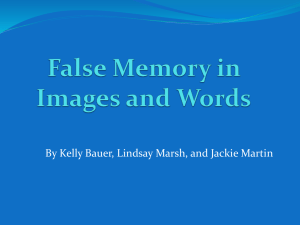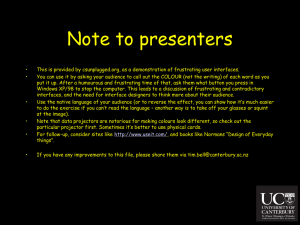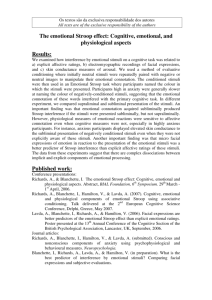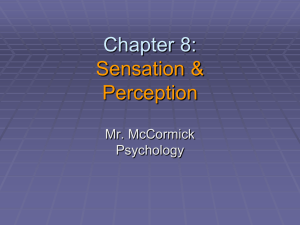doc - ray luo
advertisement
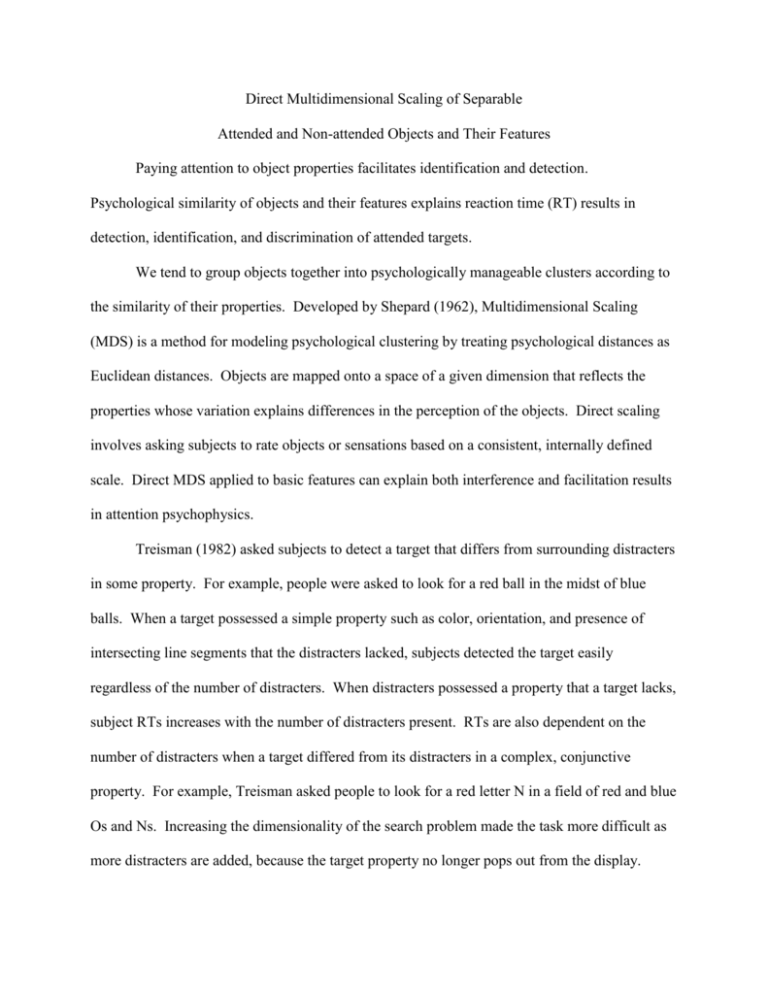
Direct Multidimensional Scaling of Separable Attended and Non-attended Objects and Their Features Paying attention to object properties facilitates identification and detection. Psychological similarity of objects and their features explains reaction time (RT) results in detection, identification, and discrimination of attended targets. We tend to group objects together into psychologically manageable clusters according to the similarity of their properties. Developed by Shepard (1962), Multidimensional Scaling (MDS) is a method for modeling psychological clustering by treating psychological distances as Euclidean distances. Objects are mapped onto a space of a given dimension that reflects the properties whose variation explains differences in the perception of the objects. Direct scaling involves asking subjects to rate objects or sensations based on a consistent, internally defined scale. Direct MDS applied to basic features can explain both interference and facilitation results in attention psychophysics. Treisman (1982) asked subjects to detect a target that differs from surrounding distracters in some property. For example, people were asked to look for a red ball in the midst of blue balls. When a target possessed a simple property such as color, orientation, and presence of intersecting line segments that the distracters lacked, subjects detected the target easily regardless of the number of distracters. When distracters possessed a property that a target lacks, subject RTs increases with the number of distracters present. RTs are also dependent on the number of distracters when a target differed from its distracters in a complex, conjunctive property. For example, Treisman asked people to look for a red letter N in a field of red and blue Os and Ns. Increasing the dimensionality of the search problem made the task more difficult as more distracters are added, because the target property no longer pops out from the display. RT differences for different types of visual search tasks can be modeled by psychological distances of constituent features. Using the letters example, we can create a two-dimensional scale of letters from A to Z and colors from red to yellow to blue to violet and back to red. Note that a map of these properties lies on outward lines perpendicular to concentric circles. Letters are not necessarily arranged alphabetically. We may consider a greater number of dimensions for the letters alone. Similarity ratings for different pairs of colorful letters can be used to map out an approximate empirical space for these two-dimensional objects. RTs are predicted to be some monotonic function of the psychological distances between target and distracter objects, plus some variance that depends on experimental conditions. Note that in conjunction search, objects vary in two-dimensions, making the RTs larger in general. In one-dimensional search, RTs for targets and distracters with similar features depend on the number of distracters, because of the reduction in variance associated with clustering together of the distracters. RTs for detecting targets with a pop-out feature do not depend on the number of distracters, presumably because the target-distracter distance is at infinity with respect to the current setup. Identification of objects varying in two dimensions depends on the separation between stimuli in similarity space (Monahan & Lockhead, 1977). Experienced subjects were briefly presented with rectangles of various heights and widths to identify as belonging to one of six predefined categories. When the six predefined rectangles were spread out in the similarity space of heights and widths, the RTs for the identification task were faster and the error rates were lower. When the six rectangles were lying in a line in similarity space, the RTs were slower and the error rates were higher. Extra dimensionality facilitates identification in this case. The authors suggest that the RT result is due to the difference in discriminability among objects presented. Stimuli can be divided into two classes. Integral stimuli yield a Euclidean metric in similarity scaling (Shepard, 1962), and a decrease in RT when identifying stimuli with redundantly combined dimensions. Nonintegral stimuli yield a block distance metric, and no interference when objects vary in an irrelevant dimension in addition to the dimension along which identification is performed. The authors suggest a definition of integrality as a property of objects for which attention to one aspect of the stimulus automatically invokes awareness of its other aspects. Identification of an integral stimulus is automatically invoked; identification of its attributes is only invoked by attentive effort. Nonintegral, or phenomenological stimulus, on the other hand, invokes identification of its attributes automatically; its own identity is discerned only through attention. In Treisman’s experiments, simple target-distracter pairs are phenomenological, while conjunctive pairs are integral. Indeed, simple targets are detected easily by discrimination of its attribute among distracters, regardless of dimensionality of the distracters. Conjunctive targets are found by attentional visual search that becomes more difficult as distracter dimensionality increases. Monahan and Lockhead showed that MDS analysis must be adapted to the particular experimental situation. In their setup, you can’t ask people how different two rectangles are. Direct scaling makes no sense because relationship among the stimulus set, not between stimulus pairs, is responsible for the RTs. Hence the authors utilized an information-theoretic approach to evaluate the discriminability of stimulus sets. Sets that vary along a line in two dimensions have only one degree of freedom while sets that vary maximally in two dimensions have two. Thus you only need one bit of information to specify the lengths and widths of the one dimensional set; you need two bits for the two dimensional set. With a brief presentation time that raises the variances of the perceived target configuration, the increased information associated with twodimensional sets gives us a faster and more accurate identification. This example suggests that MDS can always be approached from an information theoretic view point (Cutting, 1987). Perceptual distances specify the information content in discrimination between a pair of objects: greater Euclidean distance implies greater information content. Stroop examined a color discrimination task in which subjects were asked to give the colors in which common words are written. When the color of the word matches the actual or semantic content of the word, RTs were fast. When the color of the word contradicts the color term specified by the word, RTs were slow. For example, subjects were fast in specifying the color green for a patch of green, as well as the word “green” written in green, as well as the word “grass” written in green. Subjects were slow in specifying the color red for the word “green” written in red, as well as the word “grass” written in red (with a smaller effect). Stroop showed that automatic linguistic reactions interfere with the verbal specification of color. In the language of Monahan and Lockhead, colored words are integral stimuli, because they automatically invoke a semantic interpretation without regard to their color attribute. Patches of color are phenomenological stimuli, because their color attribute is immediately perceived. Indeed, Treisman’s detection task involving a target red ball amongst distracter blue balls is a detection version of the Stroop control task. Naming the color of incongruent word-color pairs is a variant of the conjunctive search in which mismatch is maximal. MDS can be applied to the Stroop Effect as long as we treat a feature equally with an object and invert the RT-distance relationship amongst objects to account for between-object interference. In the multi-dimensional space of all words, “grass” and “green” are close with respect to the distance between “red” and “green.” In the space of all relevant words, superimpose the dimension of physical color. Presumably, the physical “green” is psychologically close to the word “green.” The Stroop Effect shows that large distances in this multi-dimensional similarity space caused by presentation of the red word “green” causes large RTs and error rates. Note that naming words of a uniform gray color and naming colors of uniform patches are lower dimensional slices of the MDS map. These tasks are faster because lower dimensional distances are shorter, indicating smaller interference of information. Note that unlike detection and identification, interference effects in discrimination reactions make RT predictions that are proportional to psychological distance between target and distracter stimuli. Semantic red interferes strongly with message “green,” even though they are at opposite poles of the scale. One explanation is that the Stroop task involves an excess of attention while the Treisman and Monahan tasks involves a poverty of attention. Attention hinders performance in the former case, and facilitates performance in the latter cases. The reason for the effective asymmetry of attention is the linguistic content of the stimuli in the Stroop task. Thus, the competition of dissimilar stimuli across two dimensions hinders response in the Stroop task, but reinforces response in selection and detection. It has been shown that the Stroop Effect still holds when conjunction of color and word is taken away. For example, specifying the green color of a patch lying next to the word “red” is slower than specifying the color without the word (Prinzmetal, 2002). Increasing the distance between the patch and the word decreases the effect. The spatial dependence of the Stroop Effect can be modeled by increasing the dimensionality of the MDS to accommodate Euclidean spatial distance. An information-theoretic approach to MDS allows us to model psychophysical results in detection, identification, and discrimination. Treating visual search as a special case of information-maximization via distance-minimization shows the utility of MDS. Unattended interference in a separate dimension can be explained by coupled MDS and the definition of integral stimuli. MDS provides a useful generalization for psychophysical models in attention. References Cutting, J. E. (1987). Perception and information. Annual Review of Psychology, 38, 61-90. Monahan, J. S., & Lockhead, G. R. (1977). Identification of integral stimuli. Journal of Experimental Psychology: General, 106, 94-110. Prinzmetal, W. (2002). Personal communication. Cognitive Science 126 lecture on attention, November 14, 2002. Shepard, R. N. (1962). The analysis of proximities: Multidimensional scaling with an unknown distance function: I & II. Psychometrika, 27-28, 125-140, 219-246. Stroop, J. R. (1935). Studies of interference in serial verbal reactions. Journal of Experimental Psychology, 18, 643-660. Treisman, A. (1982). Perceptual groupings and attention in visual search for features and for objects. Journal of Experimental Psychology: Human Perception and Performance, 8, 194-214. Direct Multidimensional Scaling of Separable Attended and Non-attended Objects and Their Features Ray Luo Cognitive Science 126

